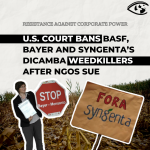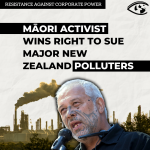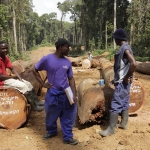LATIN AMERICA: Victims of Glyphosate
The pain and suffering of victims of toxic agrochemicals invaded the international negotiations on biosafety in Curitiba, Brazil this week with the accounts of a Paraguayan mother whose son died from herbicide poisoning and local residents of a neighbourhood in Córdoba, Argentina facing a severe health crisis caused by the fumigation of surrounding fields.
The Third Meeting of the Parties to the Cartagena Protocol on Biosafety (MOP3) is taking place Monday through Friday in this southern Brazilian city.
Ninety minutes before the start of a panel on "Victims of Agribusiness at the Biodiversity Summit" on Wednesday, Paraguayan activist Petrona Villasboa was describing to IPS the circumstances of the death of her 11-year-old son Silvino Talavera when Brazil's federal police interrupted her.
The police were trying to detain two foreign activists from the groups that organised the panel - the Rural Reflection Group from Argentina and the Network for a Transgenic-Free Latin America - on charges that they had entered the country illegally.
The police alleged that irregularities had been committed by people entering the venue where MOP3 is being held, and that they were thus checking the documents and entry visas of those taking part in the "Victims of Agribusiness" panel.
The police action was called off after Brazilian diplomats and officials from the Secretariat of the Convention on Biological Diversity intervened.
Because she was poor and lived in a community without health care, Villasboa was unable to save her son when he was poisoned by agrochemicals. The boy was directly sprayed when one arm of a machine fumigating a nearby field jutted into the road along which he was riding his bike.
The incident occurred on Jan. 2, 2003 in Itapua, in southern Paraguay, next to a field of transgenic soy belonging to Brazilian farmer Herman Schelender.
When he was sprayed, Silvino was carrying a package of meat that he had just bought. The contaminated meat was eaten by the family, and after the meal, Silvino said he had a stomach ache and felt nauseous.
Villasboa, a mother of 10, thought she had taken care of the problem with a home remedy. But four days later, toxic agrochemicals were sprayed by another local farmer, just 15 metres from the house, and the entire family was intoxicated.
The cumulative effect was too much for Silvino. "He told me that night that he no longer had pain in his stomach, but in his bones," said Villasboa. In the wee hours of the morning, spots of blood appeared on his body, and his desperate mother asked a neighbour to drive him to the nearest health clinic.
Although the doctor diagnosed acute poisoning with agrochemicals, he said he could do nothing because he did not have the necessary medication or equipment.
Several hours later, the boy's body was completely paralysed, and he was taken to a hospital in the city of Encarnación. His stomach was pumped, but in vain. His mother was beside him when he died.
In a panic, Villasboa rushed home to take her two-year-old daughter to the hospital, and the little girl's life was saved. She did the same with the rest of her children, who were taken to the hospital the next day in an ambulance.
Blood tests revealed that her children had been contaminated with three kinds of agrochemicals, including glyphosate, an herbicide used in the cultivation of Roundup Ready transgenic soy beans, which are produced by U.S. biotech giant Monsanto.
Villasboa decided to give her personal testimony at the MOP3 in order to seek international assistance in the face of the power of the rural producers who are responsible for poisoning her family.
A judge found the two farmers involved - Herman Schelender and Lauro Lautenlager - guilty of involuntary manslaughter, and sentenced them to two years in prison. The day after the verdict was handed down, Villasboa received a death threat. The farmers have appealed the ruling.
Villasboa is now the head of the National Coordinating group of Indigenous Women, an organisation of 4,000 rural women, in her province.
In the other case reported Wednesday, the victims are the 500 residents of a neighbourhood in the central Argentine city of Córdoba. The district, Ituzaingó Anexo, is surrounded by fields of transgenic soy, which are sprayed from crop-duster planes.
The number of cases of leukemia and other cancers, skin diseases, and birth defects has soared since glyphosate began to be used on the surrounding fields.
"Less than a month ago, Dr. Edgardo Schinden released the results of an independent study that states that our neighbourhood should be evacuated," said SofÃa Gatica, a women's group activist. "But the government of Córdoba has not recognised the findings of the report, and has offered to pave the streets and set up a health post, rather than making any effort to eliminate the source of contamination."
Blood tests have detected several types of toxic chemicals in 30 children, she said.
"The authorities told us that the contamination is within acceptable limits. Is there a limit to how contaminated we can be? Is there a limit to the illnesses invading our families?" asked the activist.
Transgenic soy involves "farming without farmers, where the only thing you hear is the wind," said one of the organisers of the panel.
An ad produced by the Syngenta seed company, which was shown at the beginning of the panel's meeting, shows a map of Argentina, Bolivia, Brazil and Paraguay, dubbed "The United Republic of Soy".
"The transnational agribusiness corporations are promoting a new colonialism in Latin America, and the worst thing about it is that all of these damages are caused just to feed livestock in Europe and China," said Jorge Ruli, an Argentine activist with the Rural Reflection Group.
At the MOP3, a global coalition of non-governmental organisations protested the New Zealand delegates' defence of the U.S. position in the negotiations on biosafety. The United States, which has not signed the Cartagena Protocol, is opposed to the labeling of transgenic crops in international trade, even though it implements strict controls itself on imports containing genetically modified organisms (GMOs).
The Protocol, which entered into force in September 2003, is aimed at protecting biological diversity from the potential risks posed by living organisms modified by means of biotechnology.
The United States is the world's biggest producer of transgenic or genetically modified varieties of crops, which are produced in laboratories by inserting genes from different plants or even animals into a crop.
The environmentalists urged New Zealand not to block the negotiations on the Cartagena Protocol with its unexplained opposition to strict labeling rules that would clearly identify the presence of GMOs in cross-border shipments of foodstuffs and animal feed.
In a statement distributed to the press, the activists noted that the import laws in New Zealand itself are among the most stringent in the world, requiring zero contamination with GMOs and clear labeling for consumers. So why is that country trying to keep others from having similar controls? they asked, complaining about double standards.
Switzerland and Brazil chair the contact group set up to unblock the Cartagena Protocol negotiations on labels that would clearly state "contains GMOs".
Brazilian Ambassador Luiz Figueiredo Machado, the co-chair of the contact group, told IPS that a proposal set forth by his country was serving as the basis for the search for a consensus on the Protocol's clause on labeling, the most controversial aspect of the treaty. The proposal would give countries four years to adjust to the new rule on labeling and separation of transgenics.
- 181 Food and Agriculture



